I’ve cooked with many different fabrications of cookware throughout my career, and one day I sat down to think about how I choose which type of cookware to use on any given day. While I found that I often chose cast iron based on what it was I was cooking, I also discovered that I pick cast iron for those special occasions when I’m cooking for those I love, for holidays or for those occasions when I have all the time in the world to sit back and enjoy cooking. There’s just something about cast iron, the way the aroma of slow cooked stews fills the house, the beautiful sear that it gives to meats, the solid sturdy temperament of the cookware which you know will be with you for years to come that makes you feel you have a real partner in the kitchen.
So, what is it about cast iron cookware that makes some home cooks swoon? Why do so many cooks know they can rely on cast iron to hold up its end of the deal in the task of making dinner? It truly comes down to the construction of the cookware and the main property of iron, which is how it not only conducts, but also maintains heat. Now, it’s this same property – how cast iron conducts heat and holds onto that heat – that makes using it a challenge for some new cooks, or cooks who are used to cooking with aluminum. The following article will give you some insight into cooking with cast iron, but let’s start at the beginning.
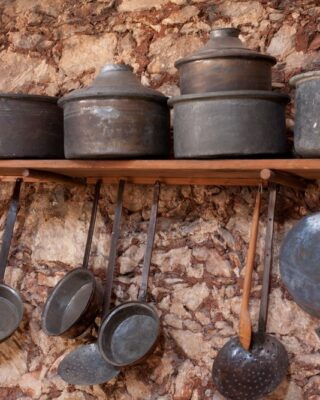
History of Cast Iron Cookware
Cast iron vessels for cooking have been around since the 6th century B.C. in China and were used throughout Europe in the Middle Ages, but it wasn’t until the middle of the 19th century that cast iron cookware arrived in North America, when either cast iron pots with lids and handles were hung over fires to cook foods or legged pots were placed in the coals for the same purpose.
In the late 19th century, American manufacturers of cast iron began creating cookware with flat bottoms to suit indoor kitchen stoves. This type of cookware was relatively inexpensive and therefore popular. It was durable and could be passed down from generation to generation and can still be found in antique stores and family yard sales all over. Cast iron cookware fell out of popular use a little in the late 20th century when aluminum and non-stick cookware came into fashion, but has come back in vogue in recent years.
How is Cast Iron Cookware Made?
Cast iron cookware is just that – iron that is cast in a mold into a shape. To do this, molten iron and steel are combined and poured into a mold made of sand, water and powdered clay. Once the iron has cooled and solidified again, the mold is broken to release the cookware and then smoothed down so there are no rough edges. At this stage, the pot is classified as “bare cast iron” and is what you may have seen in the kitchens of those generations who came before us. It is plain black in color and made of one solid piece of metal, including the handle. Lodge is one of the oldest American manufacturers of bare cast iron cookware.
The other type of cast iron cookware that has become very recognizable is “enameled cast iron”, made popular by companies like Le Creuset or Staub. These pots and pans come in beautiful colors on both the inside and outside, adding a pop to any kitchen decor. Enameled cast iron starts off as bare cast iron, but has a vitreous enamel glaze applied to the surfaces, creating a non-porous surface that is not only easier to clean than raw cast iron, but has better non-stick properties as well. It’s no wonder it has become so popular, although the price of enameled cast iron can be three or four times as much as bare cast iron.
Almost any type of pot or pan can be found made of cast iron, but the most common shapes by far are the skillet and the Dutch oven.
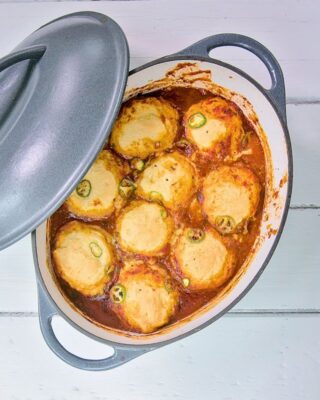
The Dutch Oven
A “Dutch oven” is basically a cylindrical pot with thick walls and a tight-fitting lid. If you could only have one piece of cast iron in your kitchen, this would be a leading contender. It is versatile enough to be used for slow cooked braises, like coq au vin, or for deep frying chicken, or even for baking breads. The heavy, tight-fitting lid keeps heat inside the pot, turning it into an oven. It also holds moisture and helps to retain more flavor in the food. The high temperature resistance of the pot also makes it able to be used on the stovetop or in the oven, or in the case of bare cast iron, over a campfire.
The term “Dutch oven” refers to the process of how the cast iron pot is made – in a sand mold, as opposed to a mold made of clay. It was the Dutch who used sand for molds when making brass pots and kitchen utensils and it was from this Dutch process that the method of making cast iron cookware was derived.
Why Cook with Cast Iron?
There are tons of reasons to cook with cast iron.
- Durability. First of all cast iron is incredibly durable. It can last for at least your own cooking life and probably that of the next generation as well. As a result, it couldn’t be more economical, even if you choose a high-end brand, but especially if you go with raw cast iron.
- High Heat Resistance. Cast iron can withstand extremely high temperatures on the stovetop, in the oven and under the broiler.
- All Stovetop Types. Cast iron can be used on any type of stovetop – electric coil, glass, gas and even induction. That means that no matter what type of range you have now or in the future, this cookware will work for you.
- Open Flame Cookware. Raw cast iron can be used in an open fire, so your camp dinner fantasies can be achieved.
- No Non-Stick Concerns. You don’t have to worry about using cast iron over high heat as you do with non-stick coated pans because cast iron has extremely high heat resistance.
- Easy to Maintain. With enameled cast iron, clean up is very easy (see below). Even raw cast iron is easy to maintain if you season the pan regularly and clean properly (again, see below).
More than all of the above, however, the reason to use cast iron comes back to that property that we identified earlier – cast iron conducts heat effectively and holds onto heat. Unlike copper that gets hot quickly and also cools quickly, cast iron takes a little time to get hot, but once hot, it holds onto that heat or takes quite a while to cool down. This is great for some cooking methods. For instance, when you want to sear a steak you need high, constant heat. You want to use a pan that will get hot and hold that heat rather than cool down when you put a cold steak into it. Cast iron is your friend in this instance. Cast iron is also helpful when you want to cook on lower heat too. By holding onto whatever heat you give it, it creates a constant, steady environment that keeps braised foods cooking at a steady rate without a lot of variation. You just have to be the master of how much heat you give the cookware.
Cast iron is not for cooking methods that call for immediate temperature changes, like candy-making or caramel. Where most cooks run into trouble with cast iron is when they heat it too much and are then stuck with a hot pot that needs a fair amount of time to cool down. If you accidentally heat cast iron too hot, you will find yourself in a bind. So, to avoid this predicament and to get the most out of your cast iron cooking, check out the tips below.
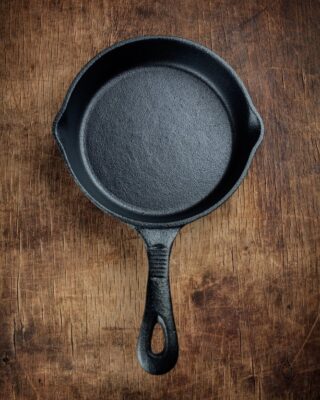
Seasoning Raw Cast Iron
Bare cast iron does require a little attention before it can become your favorite cooking vessel. Because there is no coating on the iron, it can rust if not taken care of. There is a process called seasoning that protects the surface from rusting and helps create a surface that is easy to cook with, releases foods more easily and cleans up more effectively. Seasoning a pan involves heating a cooking oil in the pan for long enough that the fatty acids in the oil oxidize and transform themselves into a new layer of molecules. This layer bonds to the metal and gets trapped in the pitted surface of the pan. The result is a slick coating that continues to get more slippery and durable each time you cook with oil. Here’s how you season a raw cast iron pan:
- Wash the pan thoroughly. The goal here is to remove any residue, pre-existing oil and rust, so using steel wool and warm water is appropriate.
- Dry the pan completely. You don’t want any excess moisture on the pan, so heat it on the stovetop for several minutes to ensure it is fully dry.
- Pre-heat the oven to 300ºF and place a sheet pan on the very bottom rack.
- Rub either grapeseed oil, canola oil, soybean oil or flaxseed oil on the surfaces of the pan. Start with about a teaspoon of oil and use a paper towel to rub the oil into the pan in concentric circles. Then, use a clean paper towel to rub off any excess oil – you want a very thin coating.
- Place the pan upside down on the middle rack of the oven and leave it there for 10 minutes.
- Remove the pan and rub it again with a clean paper towel. This will remove any excess oil and ensure you have a thin coating.
- Increase the heat in the oven to 400ºF and return the pan (upside down) to the oven. Leave it there for an hour.
- Remove the pan from the heat (carefully) and let it cool.
- Cook with the pan following the cleaning instructions below between cooking sessions and re-season the pan as needed or every couple of months.
Cleaning Raw Cast Iron
Once you have seasoned your pan, it’s important to use minimal detergents or abrasive metals to clean the pan – that will just remove the seasoning you’ve worked so hard to apply. Instead, wipe the pan clean and wash with just a drop or two of detergent, using a chain mail scrubber or green scrubbie, but no steel wool. Then run under hot water before drying thoroughly. If food has stuck to the bottom of the pan, scrape it with a flat spatula or spoon or for really stubborn stains boil water in the pan and then scrape the bottom. I can’t over-emphasize how important it is to dry the pan completely after you wash it. Do this by heating it on the stovetop (or in the oven) for several minutes. Then, leave it on your stovetop to cool before putting it away.
Cleaning Enameled Cast Iron
Enameled cast iron is much easier to clean than raw cast iron. Although many brands claim their cast iron cookware is dishwasher safe, I prefer to wash my enameled pans by hand. They clean up very easily with soapy water and a sponge. If, however, you do have stubborn stains, just soak the pan in a 5:1 bleach to water solution for 15 minutes and then clean normally.
Tips and Tricks for Cooking with Cast Iron
- Pre-heat the pan before adding any food, including oil. Remember, cast iron pans take longer to heat than other pans, so you need to have a little patience when pre-heating. Pre-heating the pan without oil will allow it to reach a higher temperature quicker than if you have oil in it. Plus, when you add oil to a hot pan, it will be hot instantly and ready for your next ingredients.
- Pre-heat on medium heat only. Cast iron gets hot and then stays hot, so the last thing you want to do is over-heat the pan. Heat it for several minutes on medium heat only. If you try to rush things by heating the pan on high, you will over-heat it and have to wait for it to cool down.
- Use the right sized burner. This is important for any pan that you are using, but even the great heat conductivity of cast iron can’t make up for a small burner. Use a burner that is about the same size as your pan.
- Use caution. Because cast iron pans are almost always made with one piece of metal, the handle will get HOT. Get into the habit of always having a towel or oven mitt in your hand when handling cast iron pots and pans.
- Listen to your food. Many cooks have a fear of food sticking in pans and panic when they try to turn foods over. Food needs time to properly sear in a pan. If your steak, or chicken or other protein is resisting you when you try to flip it, it’s trying to tell you it’s not ready to be flipped. Wait a few more minutes and then try again. Once the food has created a seared surface, it will flip more easily.
- Deglaze. Deglazing might be my favorite culinary technique. It refers to adding liquid to a pan and scraping up any browned bits from the bottom surface. This technique is used when making pan sauces, but it also helps in cleaning up the bottom of the pan as well. Try deglazing with just water, even if you’re not making a pan sauce. It will save you when it comes time to do the dishes.
- Resist Temptation. Although it is tempting to check on your food to see how it is coming along, try not to lift the lid too often when you’re cooking with your cast iron Dutch oven. Every time you lift the lid, you lose a lot of heat and break the consistent temperature of the cookware. Check to make sure you have the right temperature, and then let the cast iron do the rest of the work for you.
- No ice water. Most cast iron can handle thermal shock, but every once in a while a pan can actually crack. It’s ok to add cool water to a hot pan, but never add ice water to a hot pan.
- Use cast iron as a cooler. Cast iron holds its temperature, whether that temperature is hot or cold. Fill a cast iron Dutch oven with ice water for 30 minutes, then drain and dry it well, fill it with cold salads or foods that you’d like to keep cold. It’s great for outdoor entertaining.
- Use cast iron as a warmer. You can also use cast iron to keep foods warm, even if you haven’t cooked the food in the pot. Boil water in the cast iron for several minutes, drain and dry well and then use it to keep warm foods warm – like mashed potatoes, for instance.

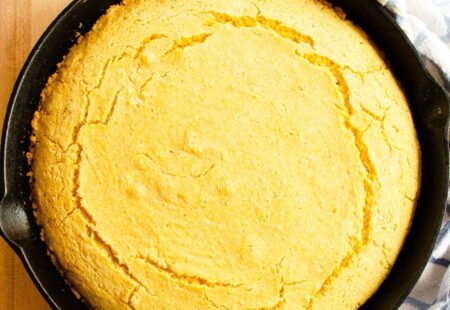

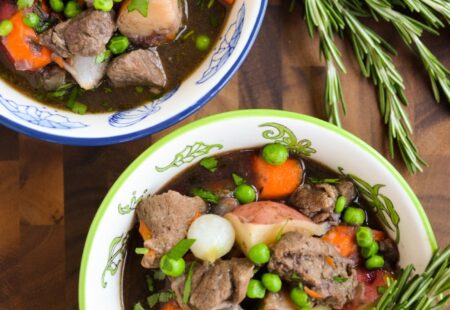

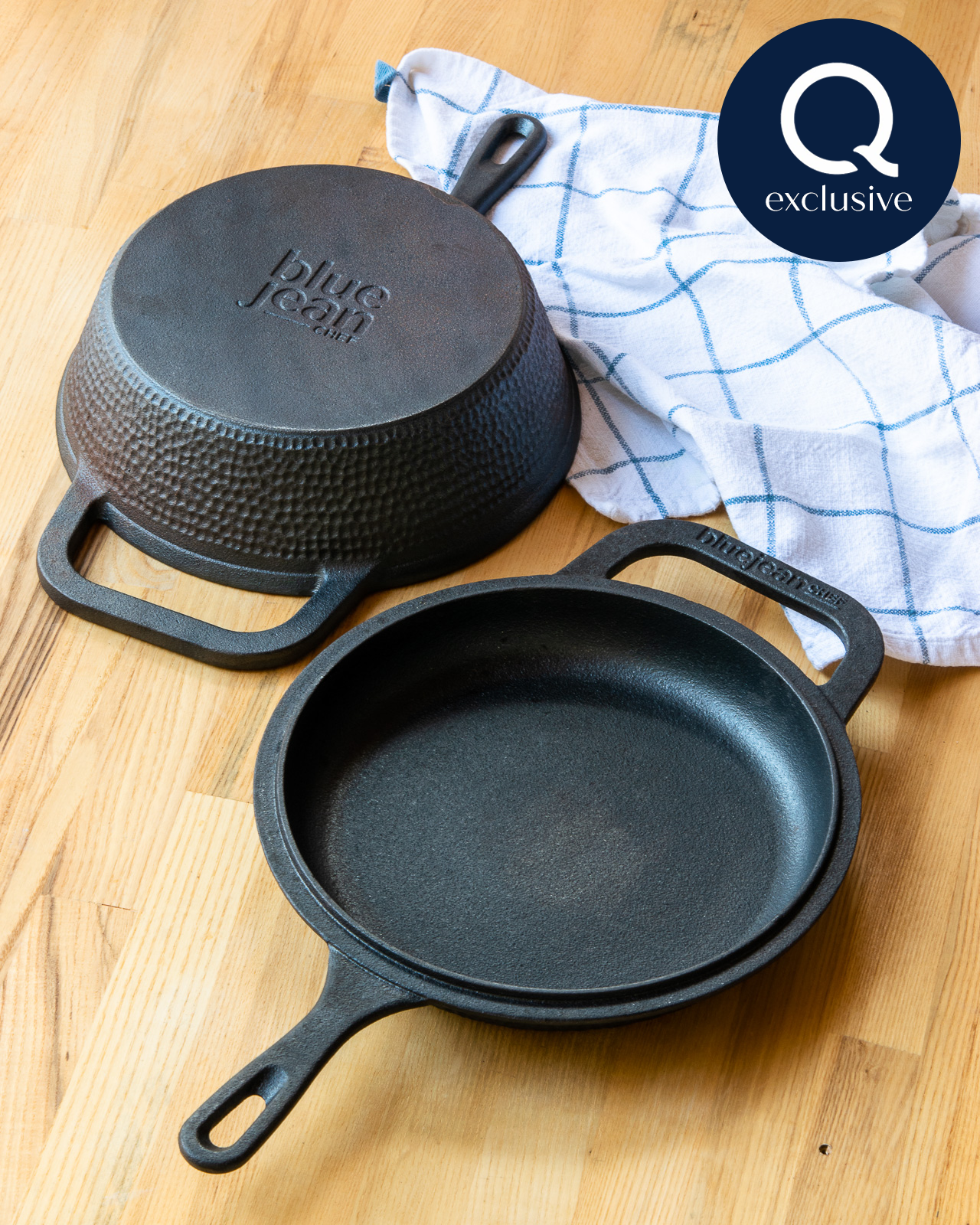

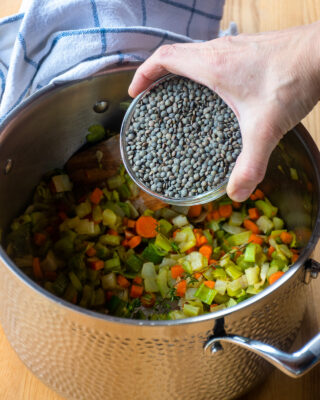
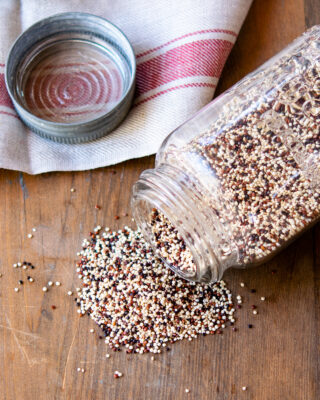


Dear Meredith,
I have a 5 qt Dutch oven (Lodge).
I have tried several times to get the bottom clean. I did the boil process and I have put it in the oven at 400* for 3 hrs,to try to bake off the bits stuck to the inside( bottom). NOTHING seems to work. What do I need to do to get it bare/clean again ?
I don’t dare continue trying to reseason until it’s a clean slate again.
Please help, what do I do?
I
Hi Corinn. If you have a build up on your cast iron, you’re right – you need to get it bare again and then re-season it. To do this, you can use a fine steel wool and hot water to really clean off everything. This will take some elbow grease and take the iron back to bare again. Wash it in hot soapy water and brush with a bristle brush or scouring pad if you need to. Then, make sure it is dry and start the seasoning process again. Remember – cast iron is tough, so you don’t need to be gentle with it when you’re trying to get it back to its raw state.
Meredith, I have cooked with raw cast iron for over 50 years, some of which were handed down to me. A lot of your care and suggestions are very helpful, even to me. Never thought about using a vessel as a warmer. I love cast iron and also love a LOT of your recipes. Thank you.
This past week, I made stew in my Dutch oven. I also recommend adding a couple sprigs of rosemary – my stew was worthy of 5 stars!!! (Hubbys opinion.) The best that I have ever made👍 Thanks for the “care” information!
if you have a self cleaning oven place the cast iron in the oven and turn on the cleaning cycle. When finished let the cast iron cool all the seasoning and build up Will be cooked off rinse and clean with sos or steel wool and soapy water. Dry and reseason as decribed.
If you don’t have a self cleaning oven you can use a hot grill closed up for about 3 hours or so.
This will save a lot of elbow grease on really bad cast iron.
Meredith, I purchased a set of enameled cast iron pots and pans and used it about four times. Each time I use it, more and more of the enamel is chipping off, revealing more and rust. Should this cookware be thrown away? I am sure the enamel chips are absorbed in the food being cooked and the rust stains can’t be cleaned. These were not inexpensive pans and it feels like cash in the trash. Help.
Hi Kathy. That is a shame! Having exposed cast iron is not a problem, but having chips of enamel in your food is not good. You can live with the chips by making sure your pan is always properly dried (either with a towel or by drying the pan in the oven for a few minutes). Then, rub a little oil on the exposed cast iron to prevent it from rusting.
I have a technique blue lightweight cast iron pan with silicone handles. Can I use it on my new gas oven?
Hi Lori. Any lightweight cast iron pan with silicone handles can definitely be used on the stovetop at any temperature and it can go into the oven up to 400ºF.
Hi Meredith.
I have several Le Creuset cookware pieces which I love, but most recently purchased a grill pan and fry pan that are non stick.
There is no need to pre season.
What is your input on non stick cast iron!
And, your thoughts on this compared to cast regular iron cookware.
Thank you in advance.
Janet
Hi Janet. I think non-stick on cast iron is great for those accustomed to cooking with non-stick. As with all non-sticks, however, it does wear over time. If you season the cast iron and maintain it properly, you can get a great cooking surface that doesn’t cause a problem, but it is work. It really depends on how much time you want to spend looking after your cookware. Non-stick is great for convenience, but there’s just something I love about using regular cast iron.
ML
Good evening, I have the Hammered cast iron vertical roaster and somehow during my last move, my instruction manual got misplaced. Is there a pdf version of the manual for this item by chance?
I absolutely love this roaster!
Thank you so much!
Hi Dawn,
So glad you love the roaster! You can find a manual to download here: https://bjcwarranty.synergyhousewares.com/manuals/BJCCIVR.pdf
ML